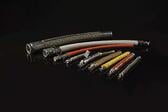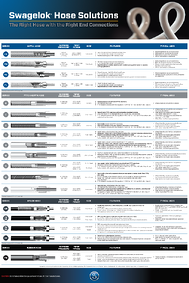Share this
Hose vs Tubing: Which one is best for an application?
by Jeff Hopkins on 5/13/15 8:00 AM
Hose can be easier to install and flex on the job
In a previous post, we looked at the advantages of tubing over pipe. Sometimes a third option makes the most sense: hose, specifically Swagleok PTFE hose.
Look around, and you'll see hose in a wide variety of applications where flexibility and longevity are needed. You'll find them in steam sterilization equipment, injection systems, steam platen presses, anywhere that the machinery goes through a repeated movement while delivering gases or liquids. On motorcycles, PTFE brake lines and cable covers prevents any moisture or road debris from getting in. For drag racers, all the nitrous oxide systems are PTFE.
Flex time
The big advantage with hose is its flexibility. When you need tubing to change direction, you have to bend it or put an adapter elbow on it. That can affect flow rates and increase pressure drop. The added components add to the overall cost. A PTFE tube with a similar pressure capability may eliminate the need for joints and elbows. In a jet airliner, PTFE is likely to be the major fuel line. In the event of an accident, the fuel line won't crack and cause a fire hazard. The flexibility of hose means that you can easily deal with an offset between any two elements of your system. As caulk is to a carpenter, hoses are to designers and installers of fluid systems.
PTFE is also tough. It's corrosion resistant and easily cleaned. If you don't physically abuse it, it can last for decades. It also doesn't conduct heat as readily as stainless steel tubing, giving you an extra measure of insulation.
End connections
When we talk about Swagelok hoses, it's also important to talk about end connections. Swagelok can put almost any type of connection on the end of our flagship PTFE hose. We use a crimping process rather than swaging, which used to be the standard. We use a circumference compression die with eight segments. The die compresses the ferrule to the end connection, preventing pull-off and allowing the hose to maintain its pressure rating. It results in much less deformation of the hose compared to swaging.
At Swagelok, each hose has its own crimp specification. We test them, making sure that we maintain the proper inside diameter.
Check out our hose page and see which ones may be right for your system. And tell us what else you'd like to know about hose. We are preparing a pocket guide to hoses, and we'd like to make sure it answers your most important questions.
Additional Resources
 |
 |
|
| Hose Selection Tutorials | Hose Assembly Services |
Share this
- Archive (465)
- Assembly Services (207)
- About (100)
- Seal Support Systems (96)
- Best Practices (88)
- Training Services (74)
- Fittings (51)
- Semiconductor Applications (49)
- Hoses and Flexible Tubing (47)
- Regulators (44)
- Tubing (42)
- Grab Sampling Systems (32)
- Sampling Systems (32)
- Gas Systems (30)
- Services (30)
- Downloads (29)
- Valves (24)
- Application Support (18)
- Orbital Welding (17)
- Case Studies (13)
- Steam Systems (13)
- Frequently Asked Questions (12)
- Tools (12)
- Measurement Devices (7)
- Subsystems (6)
- Thermal Management (6)
- September 2023 (1)
- August 2023 (2)
- June 2023 (1)
- March 2023 (3)
- February 2023 (3)
- January 2023 (4)
- December 2022 (4)
- November 2022 (4)
- October 2022 (4)
- September 2022 (1)
- August 2022 (3)
- July 2022 (2)
- June 2022 (4)
- May 2022 (1)
- April 2022 (2)
- March 2022 (1)
- February 2022 (2)
- January 2022 (3)
- December 2021 (1)
- November 2021 (6)
- October 2021 (6)
- September 2021 (8)
- August 2021 (4)
- July 2021 (3)
- June 2021 (6)
- May 2021 (6)
- April 2021 (7)
- March 2021 (5)
- February 2021 (4)
- January 2021 (6)
- December 2020 (5)
- November 2020 (6)
- October 2020 (6)
- September 2020 (8)
- August 2020 (7)
- July 2020 (8)
- June 2020 (8)
- May 2020 (6)
- April 2020 (9)
- March 2020 (7)
- February 2020 (10)
- January 2020 (21)
- December 2019 (23)
- November 2019 (21)
- October 2019 (22)
- September 2019 (21)
- August 2019 (22)
- July 2019 (23)
- June 2019 (20)
- May 2019 (23)
- April 2019 (22)
- March 2019 (21)
- February 2019 (20)
- January 2019 (21)
- December 2018 (14)
- November 2018 (19)
- October 2018 (23)
- September 2018 (17)
- August 2018 (29)
- July 2018 (11)
- June 2018 (6)
- May 2018 (5)
- April 2018 (4)
- March 2018 (5)
- February 2018 (3)
- January 2018 (3)
- December 2017 (2)
- November 2017 (4)
- October 2017 (3)
- September 2017 (2)
- August 2017 (6)
- July 2017 (4)
- June 2017 (4)
- May 2017 (4)
- April 2017 (3)
- March 2017 (4)
- February 2017 (3)
- January 2017 (3)
- December 2016 (3)
- November 2016 (3)
- October 2016 (3)
- September 2016 (5)
- August 2016 (5)
- July 2016 (4)
- June 2016 (5)
- May 2016 (3)
- April 2016 (4)
- March 2016 (5)
- February 2016 (11)
- January 2016 (1)
- December 2015 (3)
- November 2015 (4)
- October 2015 (3)
- September 2015 (4)
- August 2015 (4)
- July 2015 (8)
- June 2015 (5)
- May 2015 (3)
- April 2015 (4)
- March 2015 (4)
- February 2015 (3)
- January 2015 (4)
- December 2014 (2)
- November 2014 (3)
- October 2014 (4)
- September 2014 (4)
- August 2014 (4)
- July 2014 (5)
- June 2014 (4)
- May 2014 (4)
- April 2014 (5)
- March 2014 (4)
- February 2014 (3)
- January 2014 (4)
- December 2013 (5)
- November 2013 (3)
- October 2013 (4)
- September 2013 (3)
- August 2013 (5)
- July 2013 (5)
- June 2013 (5)
- May 2013 (3)
- April 2013 (6)
- March 2013 (4)
- February 2013 (4)
- January 2013 (8)
- December 2012 (4)
- November 2012 (6)
- October 2012 (6)
- September 2012 (4)
- August 2012 (4)
- July 2012 (4)
- June 2012 (4)

.webp?width=210&height=70&name=StickyLogo%20(5).webp)
